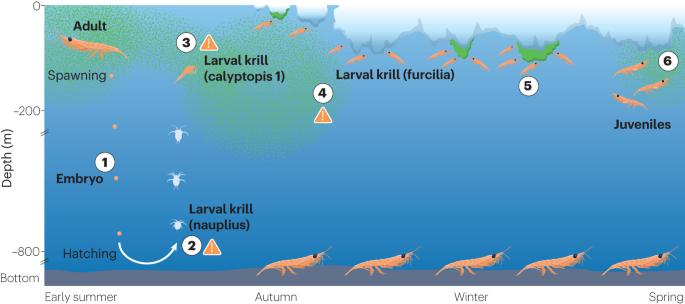Climate change impacts on Antarctic krill behaviour and population dynamics
引用次数: 0
Abstract
Krill habitats in the Southern Ocean are impacted by changing climate conditions, reduced sea ice and rising temperatures. These changes, in turn, affect krill occurrence, physiology and behaviour, which could have ecosystem impacts. In this Review, we examine climate change impacts on Antarctic krill and the potential implications for the Southern Ocean ecosystem. Since the 1970s, there have been apparent reductions in adult population density and the occurrence of very dense swarms in the northern Southwest Atlantic. These changes were associated with latitudinal and longitudinal rearrangement of population distribution — including a poleward contraction in the Southwest Atlantic — and were likely driven by ocean warming, sea-ice reductions and changes in the quality of larval habitats. As swarms are targeted by fishers and predators, this contraction could increase fishery–predator interactions, potentially exacerbating risk to already declining penguin populations and recovering whale populations. These risks require urgent mitigation measures to be developed. A circumpolar monitoring network using emerging technologies is needed to augment existing surveys and better record the shifts in krill distribution. Krill are food sources for megafauna, are drivers of carbon export and are being impacted by sea-ice declines and changing climate conditions. This Review examines changes in krill populations, habitats and behaviour in the Southern Ocean, and discusses their potential drivers and implications for fishery management in the future.


气候变化对南极磷虾行为和种群动态的影响
南大洋的磷虾栖息地受到气候条件变化、海冰减少和气温升高的影响。这些变化反过来又会影响磷虾的出现、生理和行为,从而对生态系统产生影响。在本综述中,我们将探讨气候变化对南极磷虾的影响以及对南大洋生态系统的潜在影响。自 20 世纪 70 年代以来,成年磷虾种群密度明显下降,西南大西洋北部出现了非常密集的磷虾群。这些变化与种群分布的纬度和经度重新排列有关,包括西南大西洋的极地收缩,其原因可能是海洋变暖、海冰减少和幼虫栖息地质量的变化。由于鱼群是渔民和捕食者的目标,这种收缩可能会增加渔民与捕食者之间的互动,从而可能加剧已经在减少的企鹅种群和正在恢复的鲸鱼种群所面临的风险。这些风险迫切需要制定缓解措施。需要利用新兴技术建立一个环极监测网络,以加强现有的调查,更好地记录磷虾分布的变化。
本文章由计算机程序翻译,如有差异,请以英文原文为准。
求助全文
约1分钟内获得全文
求助全文

 求助内容:
求助内容: 应助结果提醒方式:
应助结果提醒方式:


